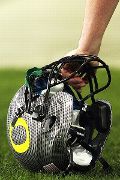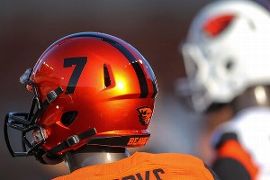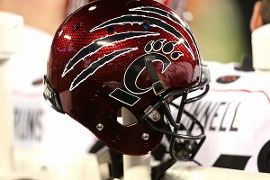NEWBERG, Ore. -- Drew Gereb was just a 37-year-old Oregon State grad with a colorful softball mask and a crazy dream when he pointed his Dodge Ram pickup south from Portland -- alone, uninvited and unannounced -- toward Corvallis and the OSU athletic offices on a Friday afternoon in March 2008.
He landed in the doorway of Steve McCoy, the Beavers' longtime director of equipment operations, who recalls meeting Gereb with equal parts annoyance and curiosity.
If Gereb had visited during the football season, McCoy, neck-deep in shoulder pads and shoes, would have never given him a second thought.
Good timing never hurts, though, and Gereb soon captured McCoy's attention.
Gereb represented Hydro Graphics Inc., a division of Finish Line Industries out of Newberg on the southwest edge of Portland. Under the direction of Chris Thom, HGI specialized in the finishing of dental chairs, gun grips, clocks, automotive, health and beauty equipment.
Basically, it was a paint shop. Still is, in fact.
Only today, HGI, as a result of that fateful Friday trip, sits at the forefront of the booming football-helmet design industry. Thom's company, shrouded in secrecy because of the sensitive nature of its work, produces prints and designs that vary from $60 to $600 for some 70 high school, college and NFL teams, including the Washington Redskins and Seattle Seahawks.
About 50 college programs this fall, in an extension of the latest arms race to look good and attract recruits, will wear helmets that feature HGI's work in collaboration with the schools and their apparel providers.
Thom's college clients include Oregon, which donned perhaps the most notable HGI look -- a silver carbon-fiber design for the BCS title game in January 2011 -- Ohio State, Georgia, Texas A&M, Notre Dame, Michigan, Texas, TCU, Iowa and Virginia Tech.
 "They're the hottest thing in college football," McCoy said. "You sit there and you look at a football helmet for 20 years and think, 'What can we do to make this different?'"
"They're the hottest thing in college football," McCoy said. "You sit there and you look at a football helmet for 20 years and think, 'What can we do to make this different?'"
HGI found a way to do it.
So just how did this company, which occupies 30,000 square feet in a nondescript building with darkened windows, progress from painting dental chairs and door frames to outfitting many of the nation's top college football programs?
After all, Thom said, "the helmet thing was never really in the plan." But in 2007 and 2008, as the economy suffered and HGI's painting business slowed, Thom's workforce shrank from 50 to 18.
One Saturday a few months before Gereb made his pitch to Oregon State, Thom called and told him to turn on the TV. They were watching college football.
"The fans were going berserk," Thom said. "These people had no idea the economy was hurting. They may not have jobs. They may have been struggling at home. But on that day, they were ready to go.
"That's when we started looking at the helmet. They're paint jobs. That's all they've ever been."
Gereb, HGI's vice president and director of business development, credits his daughter, Brionna, for inspiration. Before painting the mask she wore as a softball catcher, Gereb sought her opinion.
"Orange, black and cool," Brionna said.
Her words in mind, Gereb drove with the mask to Corvallis to find McCoy. Minutes into their meeting, McCoy was intrigued.
"There were plenty of questions," McCoy said, "but at the end of the day, I sat there and thought, 'This is where the game is going.' Your entire presentation is based around the helmet. It represents the school, but it was the most boring part of the uniform."
 HGI and its clients consulted with Riddell, which produces the helmet structure, to determine whether the new-age painting procedure would compromise the integrity of the shell. Would the design hold up under contact? Was mass production even realistic?
HGI and its clients consulted with Riddell, which produces the helmet structure, to determine whether the new-age painting procedure would compromise the integrity of the shell. Would the design hold up under contact? Was mass production even realistic?
Gereb and Thom satisfied Oregon State quickly enough that the school quietly tested a black Hydroskin helmet in the spring of 2008. In 2009, TCU became the first school to wear an HGI design in a game.
HGI expanded from six major-college clients in 2010 to more than a dozen in 2011 and 30 last season.
For Oregon State, the fancy helmets didn't fit their look until this year, when the Beavers unveiled a full uniform makeover in the spring.
"We're in a day and age right now where fashion in general has an impact on our society," Washington coach Steve Sarkisian said. "We wake up every morning, we try to decide what we're going to put on, and I think that's no different in football."
Many schools consult with apparel companies on the designs, then bring ideas to HGI, which emblazons the look on the helmet in a process that can include up to 20 steps and take several days.
Nike, based nearby in Beaverton, Ore., learned of HGI early in its rise.
"It was like, 'Oh, wow, this is amazing,' and they're in our own backyard," said Todd Van Horne, vice president and design director for Nike football. "They have all this technology. It's opened up different design opportunities and aesthetics, innovations that we can leverage and think about as we're designing what the full expression of that uniform is."
Other schools work directly with HGI on concepts. Cincinnati, for instance, came to HGI and asked for something cutting-edge.
Notre Dame, which called in 2011 as word spread of HGI's work, long painted its traditional gold helmets on campus. But the color presented a problem. It's difficult to duplicate, so the Irish tasked HGI to solve the issue.
"We went through about 25 versions to get to the point where the folks at Notre Dame were happy," Gereb said. "But we were with them on it. We wanted to make sure it was perfect."
With Notre Dame, Thom said, HGI acted sensitively, knowing the helmets had never before left campus for painting. The school sends HGI actual metal samples of gold to use in creating the paint for its helmets.
 Back in South Bend, student managers still clean and prepare the helmets for action.
Back in South Bend, student managers still clean and prepare the helmets for action.
"We didn't want to kill that tradition," Thom said.
HGI produces Hydrochrome and Hydroskin designs. Both looks employ a process in which the helmet is dipped in a tray of water that holds the design.
It's quite a clandestine operation. HGI will not reveal the entire process used to create the mirrored Hydrochrome design.
Today, curious fans can wander into the HGI offices. Helmets adorn the walls and shelves in the lobby, but new designs are closely guarded.
"They assume something is coming, but they don't know what it is, and they want to see it," said Thom, whose company still counts approximately 75 percent of its business from clients outside of helmet design. "We just can't."
In addition to the dark windows, a curtain blocks the view from the loading dock into the paint shop, where prototype helmets lay strewn and others in production hang on drying racks.
Employees are not allowed to carry cellphones with cameras on the shop floor.
There's even a room where no one without special clearance is allowed, Thom said. When Nike or Adidas reps tour the facility, the designs of its competitors' clients are removed from view.
Only once has an image leaked of a new HGI design. It happened at TCU, when a player posted a photo captured in the locker room; not the fault of HGI.
"We respect that so much," Oregon State's McCoy said. "When you're making a big decision like that as an athletic department or a university, you've got one shot to blow it out. One shot to really make your mark out there with your fan base. "If these things are leaked, it absolutely destroys that opportunity."
Gereb, upon completing the first finished look of a new Oregon State helmet for this season, wouldn't ship it to Corvallis. He refused to take a photo and send it to McCoy over email or text message. So he drove to Corvallis, retracing those first, crucial steps. When you're on the leading edge of a trend that's reshaping an industry, what's another 65 miles on the road?
"They have done something that a lot of us in the business had in the back of our minds for years," McCoy said. "They've landed on a gold mine."

